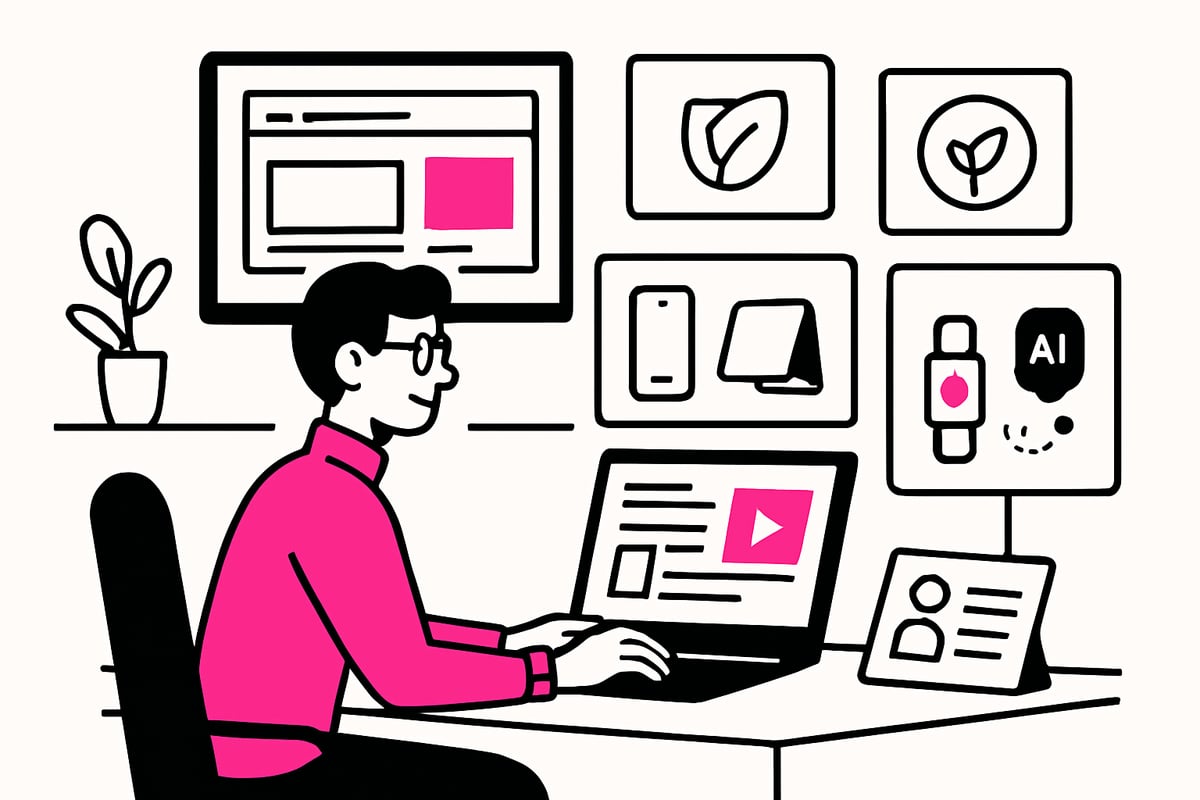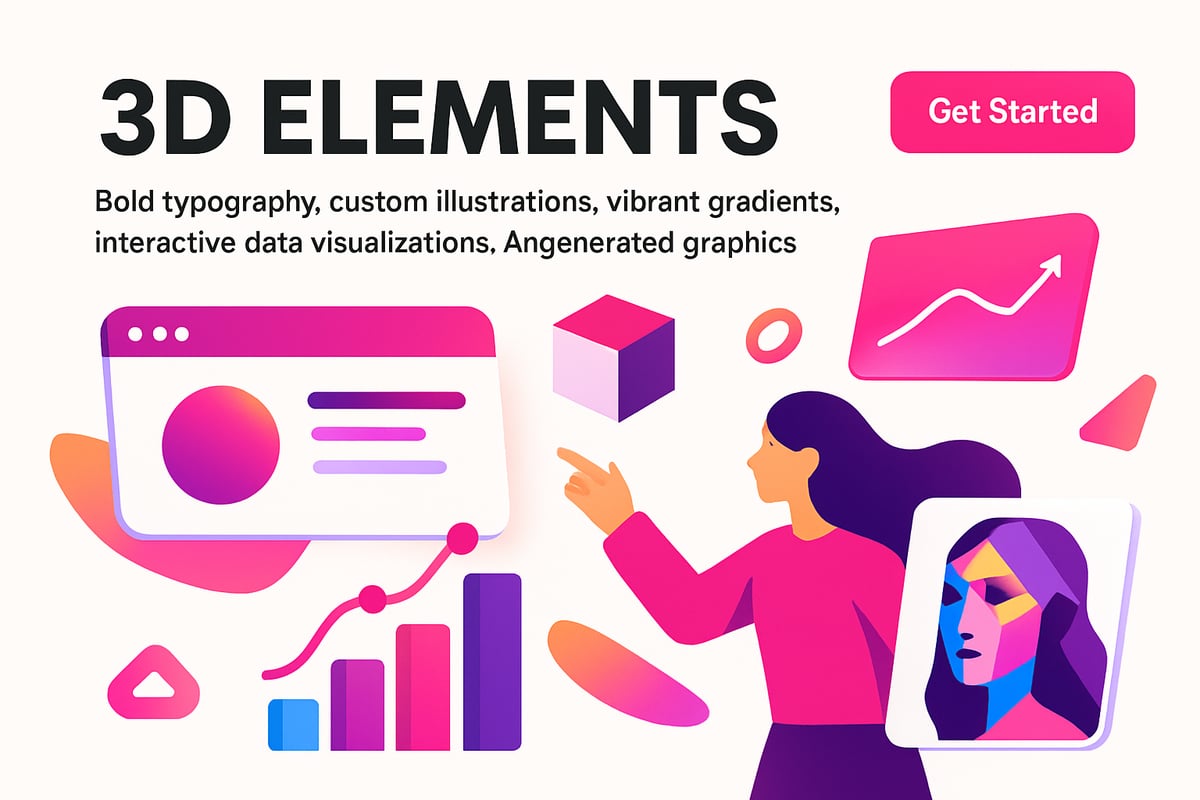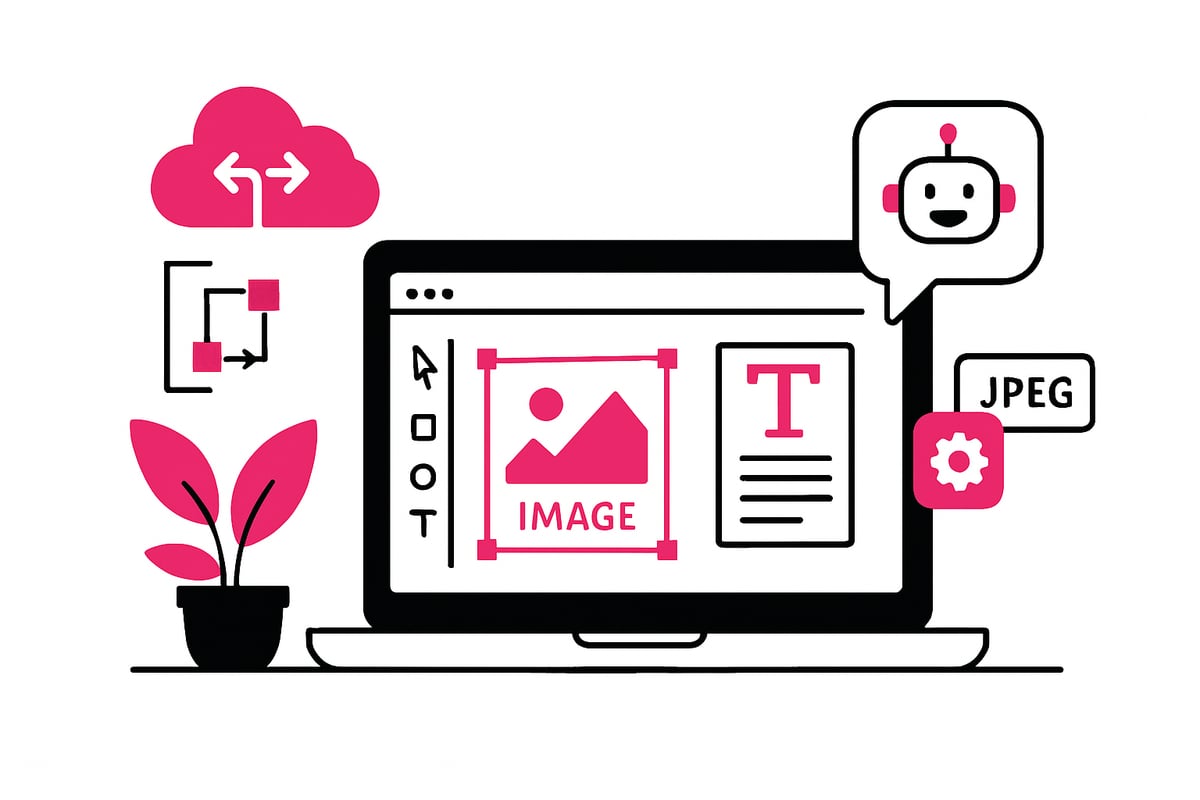Every digital story begins with a first impression. In 2025, how a brand looks and feels online can make or break its success. The world of web design and graphics is evolving faster than ever, setting the stage for how users connect, trust, and choose brands.
Design trends shift, new tools appear, and user expectations climb higher. A website’s look isn’t just about aesthetics anymore, it’s about building real engagement and lasting trust.
To stand out in this crowded digital landscape, mastering web design and graphics is essential for anyone aiming to win attention and drive conversions.
In this guide, you’ll discover the latest design principles, must-know graphics trends, powerful tools, UX/UI best practices, and step-by-step strategies to craft future-ready websites.
Emerging Web Design Principles for 2025
In 2025, web design and graphics are evolving faster than ever, driven by shifting user habits and new technologies. Picture a digital landscape where clarity, inclusivity, and sustainability aren’t just buzzwords—they’re the building blocks of every standout website. Let’s explore the principles shaping the future, and why mastering them is essential for anyone striving to capture attention and build trust online.

The Shift Toward Minimalism and Clarity
Minimalism is the new default in web design and graphics, with brands like Apple, Stripe, and Notion leading the way. Clean, content-focused layouts aren’t just about aesthetics—they boost readability and keep users engaged. According to the Adobe Digital Trends Report 2024, 68% of users favor simple, intuitive websites.
By stripping away clutter, designers reduce cognitive load. This means visitors can focus on what matters, making decisions faster and staying longer. Think of it as clearing a path through a dense forest—the journey becomes easier and more enjoyable. For more insights on these emerging principles, check out Web Design Trends 2025.
Accessibility and Inclusivity as Core Standards
Today, accessibility is non-negotiable in web design and graphics. Legal guidelines like WCAG 2.2 are raising the bar, but the real motivation is deeper—everyone deserves equal access. High-contrast colors, descriptive alt text, and keyboard navigation are now standard techniques.
Consider this: when an e-commerce site improved its accessibility, conversions jumped by 20%. That’s more than a technical upgrade—it’s a story of welcoming all users and building trust. Inclusive design isn’t just the right thing to do, it’s also good business.
Responsive and Adaptive Design Evolution
The world of web design and graphics is no longer just mobile-first. Designers are now preparing for everything from foldable phones to smartwatches and ultra-wide monitors. With 59% of global web traffic coming from mobile (Statista 2024), flexibility is critical.
Progressive web apps and fluid grids let content flow naturally across any device. Imagine a website that feels custom-built, whether you’re scrolling on a tiny wearable or a massive desktop screen. This adaptability keeps users connected wherever they go.
Sustainability in Web Design
Green practices are taking root in web design and graphics. Eco-friendly hosting, optimized assets, and dark mode aren’t just trends—they’re commitments to a healthier planet. Sustainable web choices can cut a site’s carbon footprint by up to 30%, according to the Website Carbon Calculator.
Brands that champion sustainability are discovering a new kind of loyalty. Users appreciate efforts to reduce waste, both digital and physical. Small changes, like compressing images or offering energy-saving modes, can make a big impact.
Micro-Interactions and Motion for Engagement
Micro-interactions are the unsung heroes of web design and graphics. These subtle animations—like button hover effects, loading spinners, or progress bars—guide users and deliver instant feedback. Done well, they add delight without slowing things down.
Imagine the satisfaction of seeing a button ripple as you tap it, or a progress bar that celebrates your achievement. The key is balance: motion should enhance, not distract. When used thoughtfully, micro-interactions make every click feel personal.
Personalization and AI-Driven Experiences
Personalization is transforming web design and graphics into living, adaptive experiences. AI now tailors content, product recommendations, and even site layouts to individual users. Tools like chatbots and dynamic interfaces keep visitors engaged.
Data from the Salesforce State of Marketing 2024 reveals that personalized experiences drive 15% higher engagement. Every interaction becomes a conversation, not just a transaction. In this new era, websites can feel like they truly “know” you, turning casual visitors into loyal fans.
Cutting-Edge Graphics Trends Shaping 2025
In the fast-paced world of web design and graphics, trends can spark overnight and become industry standards within a year. As we move into 2025, designers are reimagining how visuals captivate, inform, and connect. Let’s explore the most influential graphics trends shaping digital experiences and see how these creative shifts can elevate your next project.

3D Elements and Immersive Visuals
The use of 3D graphics in web design and graphics is exploding in 2025. Interactive product demos, animated backgrounds, and real-time 3D objects now draw users deeper into websites. Tools like WebGL and Three.js make it easier than ever to add dimensionality without sacrificing performance.
Brands are using 3D to create virtual showrooms and engaging onboarding experiences. These visuals boost memorability and distinguish brands in a crowded market. A well-placed 3D element can transform a static page into a living, breathing environment that users want to explore.
Bold Typography and Variable Fonts
Typography is no longer just about legibility. In 2025, web design and graphics showcase fonts as a primary vehicle for brand personality. Designers are embracing oversized headlines, expressive typefaces, and kinetic text effects to guide the eye and set the tone.
Variable fonts are especially popular, allowing for smooth transitions between weights and styles. According to a recent survey, more than half of designers plan to use variable fonts this year. This flexibility helps brands maintain consistency while still adding flair to their messaging.
Custom Illustrations and Brand Character
Stock photos are taking a back seat as custom illustrations become the hallmark of web design and graphics. Bespoke drawings, playful mascots, and unique icon sets infuse websites with personality. Companies like Dropbox and Mailchimp have built their identities around hand-drawn art styles that make their platforms instantly recognizable.
Custom graphics help brands stand out and foster emotional connections with users. By telling stories through illustration, companies can turn every scroll into a memorable narrative journey.
Gradients, Duotones, and Vibrant Color Schemes
The resurgence of gradients has brought new energy to web design and graphics. Rich, multi-color backgrounds and duotone overlays add depth without overwhelming content. Brands like Spotify and Instagram have set the tone with bold, vibrant palettes that evoke emotion and create strong visual identities.
Designers are experimenting with unexpected color pairings to break the monotony of flat design. These choices not only capture attention but also support accessibility when applied thoughtfully.
Data Visualization and Infographics
Storytelling with data is now central to web design and graphics. Interactive charts, animated infographics, and live dashboards make complex information digestible and engaging. Studies show that infographics are far more likely to be read than plain text, so integrating visual data is a smart move for any brand.
Financial apps, health trackers, and e-commerce platforms use these tools to build trust and empower users. The result is a more informed, confident audience ready to take action.
Generative and AI-Assisted Graphics
AI is revolutionizing web design and graphics by making asset creation faster and more accessible. Tools like DALL-E and Midjourney enable designers to generate unique images on demand, scaling creative output without sacrificing quality.
This technology also sparks new possibilities for personalization and experimentation. As AI becomes more integrated, designers must navigate ethical considerations and copyright issues, ensuring their creative work remains responsible and original. For ongoing insights into these evolving trends, check out Recent design perspectives.
Essential Tools and Technologies for Modern Web Designers
Staying ahead in web design and graphics means mastering a toolkit that evolves as quickly as the digital landscape itself. The right blend of platforms, prototyping tools, and AI-powered assistants can turn creative visions into seamless, engaging user experiences. Let us explore the essential technologies every designer should know in 2025.

Next-Gen Design Software and Platforms
The foundation of web design and graphics lies in versatile, collaborative design software. Figma, Adobe XD, and Sketch stand out for their cloud-based workflows, enabling teams to co-create and iterate in real time. Figma, in particular, saw its user base grow by 35 percent in 2024, reflecting a shift toward accessible, browser-based design.
These platforms allow for the creation of reusable design systems, asset libraries, and seamless handoff to developers. For a comprehensive look at the latest tools and trends shaping the industry, check out Web Design Best Practices 2025.
Advanced Prototyping and Animation Tools
Modern web design and graphics are not just static. Principle, Framer, and Lottie empower designers to bring concepts to life with interactive mockups and animated micro-interactions. These tools help communicate movement, transitions, and user flows, making stakeholder presentations more persuasive.
Interactive prototypes reduce misunderstandings between design and development teams. By visualizing behaviors early, teams can refine user journeys before a single line of code is written.
Code-Free and Low-Code Web Builders
Speed and flexibility are essential in web design and graphics. Platforms like Webflow, Editor X, and Wix Studio let designers launch responsive sites without deep coding knowledge. These tools democratize web creation, shrinking the gap between design and live deployment.
Low-code builders streamline updates and empower designers to test ideas quickly. This agility means businesses can react swiftly to emerging trends and user needs.
Asset Optimization and Performance Tools
Performance is critical for any web design and graphics project. Tools like TinyPNG for image compression, SVG optimization utilities, and lazy loading scripts ensure websites load fast and run smoothly. According to Google Web Vitals, optimized images can cut load times by 40 percent, directly impacting engagement.
A well-optimized site not only pleases users but also ranks better in search results. Prioritizing performance at every stage is a must for future-ready design.
AI-Powered Design Assistants
Artificial intelligence is transforming web design and graphics. Canva’s Magic Design and Adobe Firefly offer automated layouts, background removal, and smart content suggestions. AI speeds up repetitive tasks, freeing designers to focus on creativity and strategy.
These assistants also help generate assets on demand, making it easier to tailor content for different audiences and platforms.
Collaboration and Feedback Platforms
Teamwork is at the heart of effective web design and graphics. Tools like Miro, InVision, and Zeplin streamline communication, feedback, and handoff between designers and developers. Real-time collaboration ensures that ideas flow freely, reducing bottlenecks and misunderstandings.
By integrating feedback early, teams can iterate quickly and deliver polished, user-centered results.
UX/UI Best Practices for 2025
In 2025, web design and graphics are more than just visual elements—they are the storytellers of your brand in a fast-changing digital world. Imagine the user as the main character in your narrative, navigating a website that feels intuitive, delightful, and trustworthy. Every detail, from the color of a button to the flow of information, shapes their journey and creates lasting impressions. Let’s explore the essential UX/UI best practices that will define digital experiences this year.

Human-Centered Design and User Research
Great web design and graphics start with empathy. By stepping into your users’ shoes, you uncover their motivations, frustrations, and moments of delight. Techniques like empathy mapping and journey mapping help you visualize the user’s story from start to finish.
Successful teams create detailed personas to guide every design decision. They prototype early and often, using real feedback to refine experiences. In fact, 74% of failed projects lacked sufficient user research. Dive into Portfolio of web design work for real-world examples of human-centered approaches that build trust and engagement.
Navigation and Information Architecture Advancements
Navigation is the map that guides visitors through your website’s story. In 2025, web design and graphics prioritize mega menus, sticky navigation, and contextual breadcrumbs to keep users oriented. The goal is to reduce bounce rates and make it effortless for visitors to find what they need.
Teams invest in clear information architecture, grouping related content and labeling menus intuitively. Smart navigation anticipates user needs, providing shortcuts and visual cues. Ultimately, seamless navigation helps users feel in control, encouraging deeper exploration and engagement.
Speed, Performance, and Core Web Vitals
Fast websites win hearts. Google’s Core Web Vitals—LCP, FID, and CLS—are benchmarks every web design and graphics project must hit. A site that loads quickly and responds instantly keeps users focused on your story, not on waiting.
Consider the retailer who boosted conversions by 12% after improving performance. Techniques like image optimization, code minification, and lazy loading all keep your experience smooth. Performance is not just technical—it’s about respecting your user’s time and attention.
Mobile-First and Touch-Optimized Interfaces
With 85% of users expecting mobile parity, web design and graphics must shine on every device. Mobile-first design means starting with the smallest screen and scaling up, ensuring critical content is always accessible.
Designers craft thumb-friendly layouts, larger touch targets, and gesture-based navigation. Haptic feedback and responsive animations add a tactile dimension to digital experiences. When every tap feels natural, users stay engaged, no matter how they access your site.
Emotional Design and Storytelling
Web design and graphics have the power to make users feel something. Emotional design uses color, imagery, and copy to build connections and drive action. Storytelling transforms static pages into journeys, guiding users from curiosity to conversion.
Charity websites that use narrative-driven layouts often see increased donations. Vivid visuals and compelling copy anchor visitors to your brand’s mission. Remember, users remember how your website made them feel, long after they’ve left.
Trust, Security, and Privacy by Design
Trust is the foundation of every digital relationship. In 2025, web design and graphics must communicate security and privacy at every turn. Visible SSL certificates, clear privacy policies, and transparent data practices reassure visitors.
Designers use recognizable trust signals—padlocks, secure checkout icons, and plain-language policies. Compliance with GDPR and CCPA is essential for credibility. When users feel safe, they are more likely to engage, share, and return to your site.
Step-by-Step Guide to Building a Future-Ready Website
Building a future-ready website is like crafting a home for your brand in the digital world. Each step shapes how visitors feel, interact, and remember your presence online. Whether you’re a business owner, designer, or marketer, following a structured approach to web design and graphics is crucial for long-term success. Let’s walk through the journey, step by step.
Step 1: Define Goals and Audience
Every great website starts with a clear vision. Begin by asking, “Who am I building this for, and what do I want them to do?” Define your objectives, whether it’s generating leads, selling products, or sharing a story.
Create detailed user profiles and set measurable KPIs. For example, compare a B2B SaaS platform with an e-commerce store:
| Requirement | B2B SaaS | E-commerce |
|---|---|---|
| Primary Goal | Demo requests | Product sales |
| Key Audience | Decision-makers | Shoppers (all ages) |
| Main CTA | “Book a Demo” | “Add to Cart” |
A strong foundation in web design and graphics ensures your site speaks directly to those you aim to serve.
Step 2: Research and Benchmarking
Next, immerse yourself in research. Analyze competitors, study current trends, and gather real user feedback. What features do top performers offer? Where do they fall short?
Use tools to map gaps and discover opportunities. Conduct surveys, read reviews, and check analytics. This groundwork in web design and graphics helps you avoid costly missteps and uncover new possibilities.
Step 3: Structure and Wireframe the Experience
Now, sketch the blueprint of your site. Develop a sitemap to outline main pages and their relationships. Wireframe key screens with simple shapes and placeholders, focusing on user journeys and content flow.
This early work in web design and graphics makes it easier to spot issues before they become expensive fixes. Share wireframes with stakeholders for quick feedback, building consensus and confidence.
Step 4: Design Visual Identity and Graphics
This is where your brand comes alive. Choose color palettes, typography, and imagery that capture your unique story. Build a style guide to keep everything consistent, from icons to buttons.
Referencing a digital style guide example can provide real-world inspiration for crafting a cohesive visual identity. When your web design and graphics are aligned, your brand feels trustworthy and memorable.
Step 5: Develop and Optimize the Website
Bring your designs to life through code or a content management system. Focus on fast load times, responsive layouts, and accessibility. Optimize images, use SVGs, and implement lazy loading to boost performance.
According to Web Design Statistics 2025, sites that prioritize web design and graphics optimization see double the user engagement. Test across devices to ensure a seamless experience for everyone.
Step 6: Test, Iterate, and Launch
Before your big debut, test everything. Run usability sessions, A/B tests, and quality checks. Gather feedback, fix issues, and refine details.
Launching is just the beginning. Monitor analytics, listen to users, and stay agile. The world of web design and graphics evolves quickly, so iterative improvement keeps your site future-ready.
Step 7: Maintain and Evolve
A website is never truly finished. Schedule regular updates, refresh content, and review analytics to track progress. Stay curious and adapt to emerging trends, technologies, and user needs.
By treating your web design and graphics as living assets, you ensure your digital presence stays relevant, engaging, and ahead of the curve.
Future-Proofing Your Web Design and Graphics Strategy
Staying ahead in web design and graphics is like preparing your ship for a journey into uncharted waters. The digital landscape shifts constantly, and only those with a future-proof strategy can navigate the waves of change. Let’s explore the key moves that help brands, designers, and teams not just survive, but thrive as new technologies, user behaviors, and standards emerge.
Anticipating Emerging Technologies
Imagine the first time you saw someone interact with a virtual fitting room or ask a smart speaker to find a website. These moments signal the future of web design and graphics. AR/VR, voice interfaces, and spatial computing are moving from science fiction into daily experience.
Retailers now use AR for virtual try-ons, giving shoppers the confidence to buy online. Real estate agents offer virtual tours, letting clients step inside properties from their living rooms. As these tools become mainstream, designers must embrace flexible, immersive experiences. The secret is to experiment early, learn from pioneers, and always keep the user’s needs at the center. If you want to future-proof your web design and graphics, stay curious about the next big leap.
Building Scalable and Modular Design Systems
Building a house brick by brick is slow, but what if you could snap together rooms from a kit? That’s the promise of modular design systems in modern web design and graphics. Using atomic principles, designers create reusable components, from buttons to navigation bars, ensuring consistency and speeding up iteration.
A recent survey found companies with design systems iterate 30% faster. Design tokens, like color or typography variables, make it easy to update branding everywhere at once. These systems are the backbone of scalable digital products. Teams can focus on creativity, knowing their foundation is solid and adaptable as trends change. Modular thinking is the blueprint for future-proofing any web design and graphics project.
Ensuring Brand Consistency Across All Touchpoints
Consistency is the heartbeat of memorable brands. Whether a customer visits your website, downloads your app, or sees your print ad, the look and feel should tell the same story. Creating a unified identity across web, mobile, print, and social channels is no small feat.
Global brands invest in detailed brand books and style guides to align every touchpoint. Take a look at the OOOxDRPZ brand book PDF, which demonstrates how consistent graphics and messaging are achieved. This approach turns every interaction into an opportunity to build trust and recognition. When web design and graphics are in harmony, customers remember you—and come back for more.
Measuring Success with Analytics and User Feedback
How do you know your web design and graphics strategy is working? The answer lies in data and real voices. Key metrics like engagement, conversions, Net Promoter Score, and heatmaps paint a vivid picture of what’s working and what’s not.
Smart teams use tools like Google Analytics to track user journeys and Hotjar to visualize how visitors interact with each page. They listen to feedback, run surveys, and watch for patterns in behavior. This ongoing loop of measurement and learning helps teams fine-tune their sites, making small changes that lead to big results. Every data point is a compass, guiding you toward a better digital experience.
Investing in Lifelong Learning and Professional Development
The world of web design and graphics never stands still. What was cutting-edge last year may be outdated tomorrow. That’s why the best designers and marketers commit to lifelong learning, whether through online courses, webinars, or design communities.
Attending events like the Web Design Conferences 2025 exposes you to the latest AI-powered tools and frameworks. According to AIGA, 62% of designers plan to upskill in AI and motion graphics this year. Staying curious, sharing insights, and learning as a community keeps your skills sharp and your web design and graphics strategy ahead of the curve.
Collaborating Across Disciplines
Imagine a symphony where every musician plays in sync, creating something beautiful together. That’s the power of cross-disciplinary collaboration in web design and graphics. When designers, developers, marketers, and content creators unite, the result is a seamless, user-centered experience.
Holistic teamwork means fewer misunderstandings and faster project delivery. It also sparks creative solutions that might never surface in silos. The most successful digital products are born from open communication, shared goals, and respect for every contributor. Collaboration is the secret ingredient to lasting innovation in web design and graphics.
Adapting to Regulatory and Ethical Developments
The rules of the digital road are always evolving. Privacy laws like GDPR and CCPA, accessibility standards, and ethical AI guidelines shape how we build web design and graphics today. Staying compliant is not just about avoiding fines—it’s about building trust and protecting users.
Designers must keep up with new regulations and consider the ethical impact of their choices, especially as AI takes on a bigger role. Prioritizing transparency, inclusivity, and security is essential for creating resilient digital experiences. When web design and graphics put ethics first, everyone wins.
As we wrap up this journey through the essentials of web design and graphics for 2025, I hope you feel inspired to rethink how clarity, strategy, and a human touch can transform your brand’s story online. I’ve seen firsthand how the right blend of design choices—minimal layouts, striking graphics, and seamless UX—creates brands that truly connect and last. If you’re ready to dive deeper or want to chat about making your digital vision a reality, let’s keep the conversation going. Reach out anytime—just Email Me.

